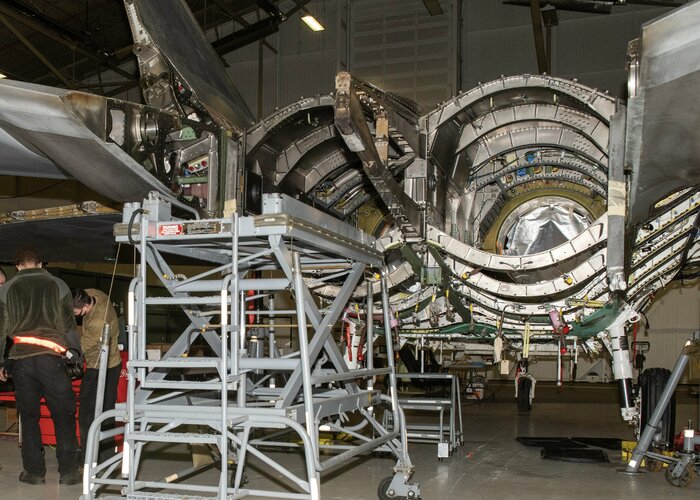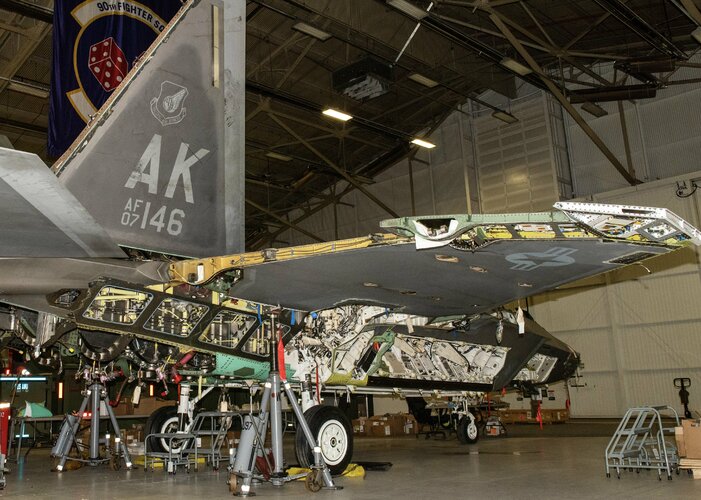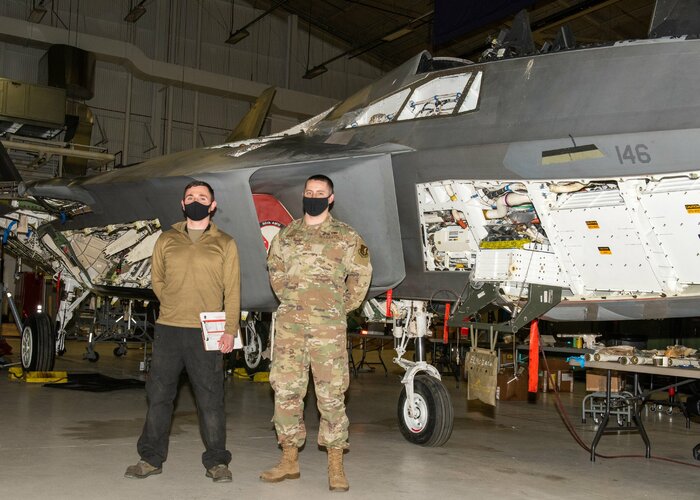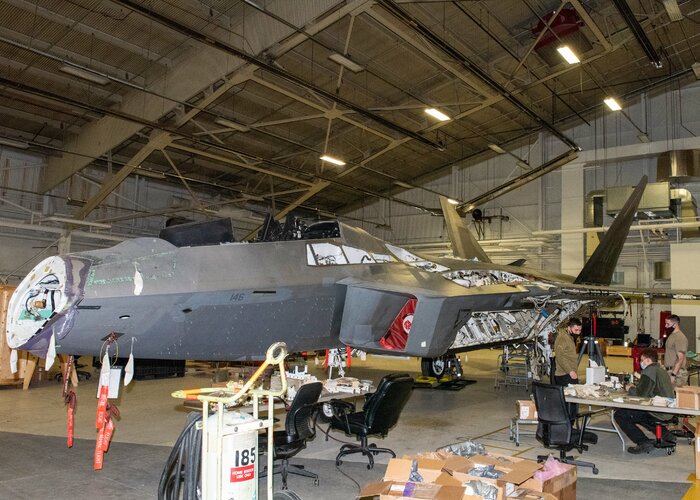You are using an out of date browser. It may not display this or other websites correctly.
You should upgrade or use an alternative browser.
You should upgrade or use an alternative browser.
Lockheed Martin F-22 Raptor
- Thread starter flateric
- Start date
- Joined
- 24 November 2008
- Messages
- 1,549
- Reaction score
- 2,606
Attachments

Senate Panel Allows A-10 Cuts, But Not F-22s | Air & Space Forces Magazine
The Senate Armed Services Committee released its version of the 2023 NDAA, with changes proposed to the Air Force fleet.
We'll see how this plays out. If those 33 Block 20 F-22s are to be retained, then I think the USAF really needs to look at how to resolve the maintenance issues with the 325th FW.
FighterJock
ACCESS: Above Top Secret
- Joined
- 29 October 2007
- Messages
- 5,594
- Reaction score
- 5,914

Senate Panel Allows A-10 Cuts, But Not F-22s | Air & Space Forces Magazine
The Senate Armed Services Committee released its version of the 2023 NDAA, with changes proposed to the Air Force fleet.www.airforcemag.com
We'll see how this plays out. If those 33 Block 20 F-22s are to be retained, then I think the USAF really needs to look at how to resolve the maintenance issues with the 325th FW.
It will be interesting to see what happens when they look at the Block 20 F-22s for those maintenance issues and see what can be done if they can be fixed at all.
zebra159357
I really should change my personal text
- Joined
- 30 November 2018
- Messages
- 99
- Reaction score
- 278

House Moves to Upgrade, Not Retire, Oldest F-22s | Air & Space Forces Magazine
The House Armed Services Committee included language in its 2023 NDAA to prevent the Air Force from retiring any F-22s.
"The Air Force’s plans to divest its oldest 33 F-22 Raptor fighters met with a sharp rebuke from the House Armed Services Committee, which moved instead to mandate the Air Force maintain the full Raptor fleet and upgrade the older planes to the newest configuration in its version of the 2023 National Defense Authorization bill."
FighterJock
ACCESS: Above Top Secret
- Joined
- 29 October 2007
- Messages
- 5,594
- Reaction score
- 5,914

House Moves to Upgrade, Not Retire, Oldest F-22s | Air & Space Forces Magazine
The House Armed Services Committee included language in its 2023 NDAA to prevent the Air Force from retiring any F-22s.www.airforcemag.com
"The Air Force’s plans to divest its oldest 33 F-22 Raptor fighters met with a sharp rebuke from the House Armed Services Committee, which moved instead to mandate the Air Force maintain the full Raptor fleet and upgrade the older planes to the newest configuration in its version of the 2023 National Defense Authorization bill."
Quite right too, a crazy idea if there ever was one. I hope that will be the last we hear of this idiotic idea by the USAF.
I feel like that’s going to be a fool’s errand part wise. I suspect junking those F-22s would lead to a larger number of available airframes for missions rather than duct taping together a fleet with a notorious lack of parts, but the die is cast.
FighterJock
ACCESS: Above Top Secret
- Joined
- 29 October 2007
- Messages
- 5,594
- Reaction score
- 5,914
Looks like the NGAD cannot come soon enough if the USAF cannot source spares from Lockheed for the F-22.
Forest Green
ACCESS: Above Top Secret
- Joined
- 11 June 2019
- Messages
- 9,455
- Reaction score
- 17,239
Surely they had a contract on spares support?Looks like the NGAD cannot come soon enough if the USAF cannot source spares from Lockheed for the F-22.
- Joined
- 3 June 2011
- Messages
- 18,326
- Reaction score
- 12,186
Depends on the type of spare. If nothing else they can use the 30 they're deactivating for parts cannibalization.Surely they had a contract on spares support?Looks like the NGAD cannot come soon enough if the USAF cannot source spares from Lockheed for the F-22.
Well they can’t now, but I’m sure that was the plan. I’d honestly be a little surprised if all of the blk20s got updated this decade from what the parts situation looks like. 17 B-1s were retired for the same reason - to take the worst cases off the books and canibalize them for the health of the rest.Depends on the type of spare. If nothing else they can use the 30 they're deactivating for parts cannibalization.Surely they had a contract on spares support?Looks like the NGAD cannot come soon enough if the USAF cannot source spares from Lockheed for the F-22.
Many of the subcontractors and underlying production simply don’t exist. It was a limited run of a fighter that wasn’t exported, unlike the F-teen series.Surely they had a contract on spares support?Looks like the NGAD cannot come soon enough if the USAF cannot source spares from Lockheed for the F-22.
- Joined
- 3 June 2011
- Messages
- 18,326
- Reaction score
- 12,186
Why can't they?Well they can’t now, but I’m sure that was the plan. I’d honestly be a little surprised if all of the blk20s got updated this decade from what the parts situation looks like. 17 B-1s were retired for the same reason - to take the worst cases off the books and canibalize them for the health of the rest.Depends on the type of spare. If nothing else they can use the 30 they're deactivating for parts cannibalization.Surely they had a contract on spares support?Looks like the NGAD cannot come soon enough if the USAF cannot source spares from Lockheed for the F-22.
- Joined
- 16 April 2008
- Messages
- 9,600
- Reaction score
- 14,460
can't they?
Read up thread; Congress said NO!
This will be a bit of a double-edged sword. If Congress mandates that those Block 20 F-22s are retained and upgraded to 30/35 standards, then they'll have to accept that the fleet availability and mission capable rates of the F-22s will not reach the 70%+ levels that they would like to see in the near term, simply because that's a lot of airframes that will be down for upgrades or awaiting spare parts, and likely eat into the logistics of the existing Block 30/35 fleet. Hopefully they and the USAF are aware of this and would allocate funding for that appropriately.
The other thing is that the maintenance problem specific to the 325th FW need to be addressed. That said, I don't know if that's simply a unit-specific issue due to the uncertainty of the unit's basing after Hurricane Michael, or some wider institutional issue with the USAF, but continually seeing F-22s scraping the runway with improperly rigged landing gears is not the way to go...
The other thing is that the maintenance problem specific to the 325th FW need to be addressed. That said, I don't know if that's simply a unit-specific issue due to the uncertainty of the unit's basing after Hurricane Michael, or some wider institutional issue with the USAF, but continually seeing F-22s scraping the runway with improperly rigged landing gears is not the way to go...
Last edited:
FighterJock
ACCESS: Above Top Secret
- Joined
- 29 October 2007
- Messages
- 5,594
- Reaction score
- 5,914
I am surprised that the Block 20 F-22s were not upgraded with the rest of the fleet to keep them up to date earlier on so that they could still be part of the wider force and not be put in the Boneyard and used for spares.
Block 20 F-22s from Lot 3 onwards, which I believe starts from 03-4041, were upgraded to Block 30 in the early to mid 2010s. The earlier lots and PRTV airframes have been with the 43rd FS, 325 FW at Tyndall until Hurricane Michael in 2018. It may be that these airframes (which were initially Block 10 upgraded to Block 20 under the Common Configuration Program) have more physical differences from the rest of the 30/35 airframes, so upgrading them was considered too expensive at the time. I believe these older jets have an older tranche of processors. Also, since these were relegated to the B-course and not deployable (like an Fleet Replacement Squadron), there wasn't an impetus to upgrade them.
Of course, we're now discovering that as the Block 30/35 fleet have undergone the software OFP and Increments over the years, the gap between them and the Block 20 airframes have widened to the point that pilots from the B-course end up having to un-learn and re-learn certain aspects on the 30/35 with their units. That said, I think Lockheed Martin actually proposed to upgrade those Block 20 aircraft to 30/35 standards back in 2016 at the same time that the production restart was being investigated, but nothing came out of that. In hindsight, perhaps that is what should have been done.
Of course, we're now discovering that as the Block 30/35 fleet have undergone the software OFP and Increments over the years, the gap between them and the Block 20 airframes have widened to the point that pilots from the B-course end up having to un-learn and re-learn certain aspects on the 30/35 with their units. That said, I think Lockheed Martin actually proposed to upgrade those Block 20 aircraft to 30/35 standards back in 2016 at the same time that the production restart was being investigated, but nothing came out of that. In hindsight, perhaps that is what should have been done.
Last edited:
FighterJock
ACCESS: Above Top Secret
- Joined
- 29 October 2007
- Messages
- 5,594
- Reaction score
- 5,914
Of course, we're now discovering that as the Block 30/35 fleet have undergone the software OFP and Increments over the years, the gap between them and the Block 20 airframes have widened to the point that pilots from the B-course end up having to un-learn and re-learn certain aspects on the 30/35 with their units. That said, I think Lockheed Martin actually proposed to upgrade those Block 20 aircraft to 30/35 standards back in 2016 at the same time that the production restart was being investigated, but nothing came out of that. In hindsight, perhaps that is what should have been done.
I wish that LM and the USAF had the will power to have gone through with the production restart and the upgrade back in 2016 icyplanetnhc (Steve). But I suppose we can always look back and wish that the F-22 production line never closed in the first place.
Interesting picture showing some of the F-22's underlying structure. You can see that the forward fuselage lower longitudinal bulkheads make an inverted V, which forms a long compartment under the nose. I think this may have been one of the spots that the AIRST was meant to go in, although more recent pictures hint at wingtip pod installation instead, which while easier and likely cheaper is also a bit disappointing, if I'm being honest. I'd be curious why that space is seemingly unavailable now; perhaps some other system is now interfering with that space and rearranging it would be cost prohibitive.
Speaking of which, per the FY23 budget request, the F-22 Gantt chart shows that Sensor Systems (which IRST is listed under) enters Tech Demo/Group B Production in Q4 of FY22, and Dev/Op Test in Q3 of FY23. I suppose that will be when we may have a better look at the implementation.

Speaking of which, per the FY23 budget request, the F-22 Gantt chart shows that Sensor Systems (which IRST is listed under) enters Tech Demo/Group B Production in Q4 of FY22, and Dev/Op Test in Q3 of FY23. I suppose that will be when we may have a better look at the implementation.
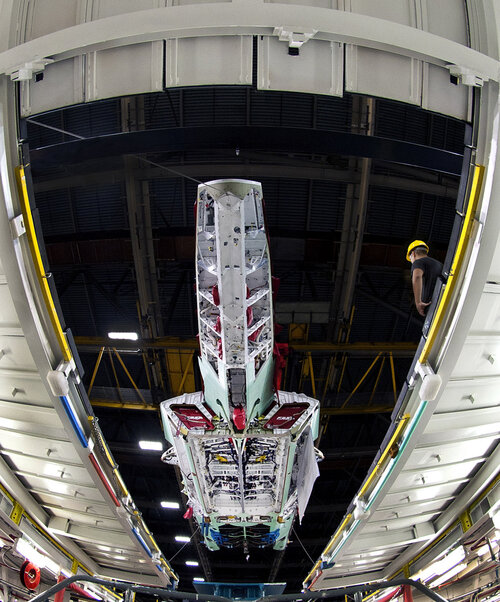
Last edited:
A dozen of Raptors are inbound to Poland:

 theaviationist.com
theaviationist.com
@icyplanetnhc (Steve) : notice how that forms a compartment that can be sealed (hence with an open access to outside air).

A Dozen U.S. F-22 Raptors Are Deploying To Poland To Enhance NATO Air Shielding
The first F-22 Raptors have arrived in the UK yesterday. More are on their way. Six U.S. Air Force F-22A Raptor, belonging to the 3rd Wing based at Joint
@icyplanetnhc (Steve) : notice how that forms a compartment that can be sealed (hence with an open access to outside air).
aonestudio
I really should change my personal text
- Joined
- 11 March 2018
- Messages
- 2,963
- Reaction score
- 7,478
The big headline for R1 is that it prepares the Raptor for JATM – the secretive new AIM-260 Joint Air Tactical Missile, designed to give U.S. fighters a new edge in air combat. “We are in the middle of getting ready for live-fire tests this summer, part of a huge joint test effort between the operational testers at Nellis, and the developmental testers at Edwards AFB, California. The JATM program is completely dependent on RACR-standard, and the F-22 needs R1 and R2 – to an extent – to shoot JATM. That’s everything from integrating the missile into our software, the indications we see in the cockpit, the information we can share with the missile, and the way we interact with the missile from a targeting perspective. There’s a lot of new technology in JATM that is much more advanced than our current [AIM-120 AMRAAM] missile’s technology.”

F-22 Raptor Being Readied For AIM-260 Missile By 'Green Bats' Testers
Inside Nellis Week: The 'Green Bats' improve the USAF's fighter fleet, including making sure the F-22 stays on top for years to come.
isayyo2
Lurker alert
- Joined
- 24 November 2011
- Messages
- 1,131
- Reaction score
- 2,323
Highlighting their IRST solution, confirmed to be a stealthy pod.
F-22 Raptor Being Readied For AIM-260 Missile By 'Green Bats' Testers
Inside Nellis Week: The 'Green Bats' improve the USAF's fighter fleet, including making sure the F-22 stays on top for years to come.www.thedrive.com
The F-22 is also getting an Infra-Red Search and Track (IRST), which is a passive sensor that can track targets at long ranges. IRST is a notable omission from the jet’s current arsenal. “It’s going to be a podded solution,” explains Autrey. “The IRST is a way to get out of the RF [radio-frequency spectrum] fight; it’s another means to a single-ship kill-chain, and it’s got a lot of attention. The technology in the IRST is very impressive. The IR kill-chain we’ve demonstrated in the Department of Defense is extremely hard to get right, and we are putting a lot of time and attention into ensuring the pod is value added to the warfighter.” The War Zone recently revealed images of an F-22 flying with the pods during testing. “The pods are going to be configured to ensure the F-22 retains its stealth capability,” Autrey confirms.
Dreamfighter
'Senior Something'
- Joined
- 13 July 2008
- Messages
- 483
- Reaction score
- 646
Didn’t the Raptor have room for an Irst they never built?
Yes, back in the days of F-22 EMD the jet was designed to have internal IRST, and AESA side-arrays as well.
But it was decided not to install those systems to the production jets to reduce/limit costs, and the Cold War was (temporarily) gone.
Available space inside the F-22 probably has been taken up by other stuff and/or fitting them internally now has become too complicated.
I think all this has been mentioned here before...
Last edited by a moderator:
isayyo2
Lurker alert
- Joined
- 24 November 2011
- Messages
- 1,131
- Reaction score
- 2,323
Yes, but a months ago in a previous War Zone article it was explained that spaces once envisioned for the cheek arrays and IRST system are already occupied.Didn’t the Raptor have room for an Irst they never built?
Last edited by a moderator:
Highlighting their IRST solution, confirmed to be a stealthy pod.
F-22 Raptor Being Readied For AIM-260 Missile By 'Green Bats' Testers
Inside Nellis Week: The 'Green Bats' improve the USAF's fighter fleet, including making sure the F-22 stays on top for years to come.www.thedrive.com
The F-22 is also getting an Infra-Red Search and Track (IRST), which is a passive sensor that can track targets at long ranges. IRST is a notable omission from the jet’s current arsenal. “It’s going to be a podded solution,” explains Autrey. “The IRST is a way to get out of the RF [radio-frequency spectrum] fight; it’s another means to a single-ship kill-chain, and it’s got a lot of attention. The technology in the IRST is very impressive. The IR kill-chain we’ve demonstrated in the Department of Defense is extremely hard to get right, and we are putting a lot of time and attention into ensuring the pod is value added to the warfighter.” The War Zone recently revealed images of an F-22 flying with the pods during testing. “The pods are going to be configured to ensure the F-22 retains its stealth capability,” Autrey confirms.
It does appear that a dual podded solution for the long range IRST integration is confirmed, although it's likely the pods will serve additional functions, likely CNI and EW. The pods are shaped in a way that would minimize impact on its signature, but it's likely still not as good as a "clean" airplane. As mentioned, rearranging the internal spaces for the original sensor position under the nose is most likely cost-prohibitive at this point.
What's interesting about the F-22 pods is that they seem to lack the air intake as seen on current EW or IR targeting pods, unless it's a "conformal" opening covered by a mesh grill. If not, then how they handle power and cooling would be very interesting, as I'm not sure if the hardpoints are plumbed for the PAO cooling circuit.
What also intrigues me is the statement that this new IRST provides a single-ship kill-chain, particularly at long range. Of course, details are understandably scarce, but it's likely related to this development.
Last edited:
- Joined
- 11 February 2010
- Messages
- 1,646
- Reaction score
- 2,695
How about having the "circuit" and heat exchanger inside the pod itself and pump fuel through that heat exchanger ?
That's possible. I recall that the F-22 fuel system was tested with external tanks on all four underwing hardpoints, so perhaps the fuel plumbs on the outboard hardpoints can cycle fuel through a heat exchanger. I do believe that the F-22 already uses its fuel as a heat sink. However, I'm not sure if the valves in the plumbed hardpoints would only allow fuel to go into the aircraft and not out; if not, an aircraft modification may be necessary if it were to take this cooling approach.
Last edited:
Might be that the pod has gateway functions(would mean that it has parts of Freedom radio in it) like Talon Hate, connecting with MADL perhaps.although it's likely the pods will serve additional functions, likely CNI and EW.
ACC Federal Laboratory flies combat apps on F-22 with new open software stack
On Aug. 24, members of the Air Combat Command Federal Laboratory, test pilots at Edwards Air Force Base, and software developers from the 309th Software Engineering Group achieved several milestones
www.edwards.af.mil
On Aug. 24, members of the Air Combat Command Federal Laboratory, test pilots at Edwards Air Force Base, and software developers from the 309th Software Engineering Group achieved several milestones on an F-22 Raptor in-flight: the first instance of third-party software running on a fifth-generation fighter, and the first in-flight use of open-source container orchestration software on any fighter aircraft.
Fifth-generation fighter aircraft are historically unavailable to third-party software integration. To fix this problem and lower the barriers to entry, the team built and flight-tested their new Open Systems Enclave (OSE) consisting of a government-owned software architecture with existing on-board hardware. This new enclave proved it can rapidly integrate new technologies from first line of code to flight in less than 60 days. In recognition of this value proposition, there is now a formal requirement for the establishment of OSE on F-22 at the direction of the Chief, F-22 Requirements.
Earlier this year, there were solicitations from AFVentures Small Business Innovation Research (SBIR) for F-22 upgrades, and this Open Systems Enclave may very well be a key enabler of that.
Also covered by AWS&T and FlightGlobal.

F-22 test demonstrates first use of third-party software on fifth-gen fighter
The US Air Force conducted the test flight as part of a Pentagon push for open-source applications and faster technology integration.
Flight Test Clears F-22 Fleet To Accept Third-Party Software | Aviation Week Network
The Air Combat Command Federal Laboratory installed and flew a new application on the F-22 within 60 days of writing the first software line of code.
What's interesting is that the third-party software will reportedly be containerized; an article published by Red Hat in 2019 highlighted the used of their Kubernetes OpenShift Container Platform to enable faster software updates. So the OSE may very well be developed from OpenShift. Speaking of containers, I've only ever dabbled a bit with Docker a few years ago (also a Kubernetes platform), and containerization is now widely employed in enterprises such as Amazon Web Services.

Lockheed Martin Taps Red Hat to Accelerate F-22 Raptor Upgrades
Lockheed Martin chose Red Hat Open Innovation Labs to lead them through the agile transformation process and help them implement an open source architecture onboard the F-22 and simultaneously disentangle its web of embedded systems to create something more agile and adaptive to the needs of the...
Last edited:
There is footage of an F-22 tumbling in that manner, but only during a flight control test where the airplane was intentionally departed and the control laws then automatically recovered the jet, i.e. it was not tumbling and spinning in a controlled manner.
View: https://youtu.be/VOro3MDF_sI
Also, disregard the title as this is an EMD F-22, tail number 91-4003 I believe, and not a YF-22.
EDIT: The video title has now been fixed.
Also, disregard the title as this is an EMD F-22, tail number 91-4003 I believe, and not a YF-22.
EDIT: The video title has now been fixed.
Last edited:
aonestudio
I really should change my personal text
- Joined
- 11 March 2018
- Messages
- 2,963
- Reaction score
- 7,478
FighterJock
ACCESS: Above Top Secret
- Joined
- 29 October 2007
- Messages
- 5,594
- Reaction score
- 5,914
I cannot believe that it has been 25 years of the F-22 Raptor.
Last edited by a moderator:
F-2
ACCESS: Top Secret
- Joined
- 22 May 2020
- Messages
- 880
- Reaction score
- 1,710
https://www.airforcemag.com/PDF/MagazineArchive/Documents/1997/July 1997/0797raptor.pdf unveiled two days after my sister was born. Also I still love the EMD scheme
I cannot believe that it has been 25 years of the F-22 Raptor.
Last edited by a moderator:
kaiserd
I really should change my personal text
- Joined
- 25 October 2013
- Messages
- 1,657
- Reaction score
- 1,726
Good chance I bought that magazine just for that articlehttps://www.airforcemag.com/PDF/MagazineArchive/Documents/1997/July 1997/0797raptor.pdf unveiled two days after my sister was born. Also I still love the EMD scheme
I cannot believe that it has been 25 years of the F-22 Raptor.
I cannot believe that it has been 25 years of the F-22 Raptor.
Last edited:
FighterJock
ACCESS: Above Top Secret
- Joined
- 29 October 2007
- Messages
- 5,594
- Reaction score
- 5,914
I cannot believe that it has been 25 years of the F-22 Raptor.
I remember DID's F-22 Raptor flight simulator as I had a copy all those years ago, brings back memories.
Colonial-Marine
UAVs are now friend, drones are the real enemy.
- Joined
- 5 October 2009
- Messages
- 1,468
- Reaction score
- 1,323
My father fondly talks of the time he spent playing Jane's ATF and other sims featuring the fighter of the future back in the day.
In that context it's rather upsetting that the F-22 never really achieved its full potential IMHO. Much like the F-14 despite both aircraft being media stars for their respective services.
In that context it's rather upsetting that the F-22 never really achieved its full potential IMHO. Much like the F-14 despite both aircraft being media stars for their respective services.
- Joined
- 21 April 2009
- Messages
- 13,741
- Reaction score
- 7,650

Congress should stop the Air Force from retiring F-22s - Breaking Defense
As China looms, the Heritage Foundation's JV Venable argues for saving 33 F-22s from the chopping block.
Similar threads
-
-
Lockheed Martin F-16 Fighting Falcon Developments
- Started by seruriermarshal
- Replies: 630
-
Lockheed Martin F-35 Lightning II Joint Strike Fighter (JSF)
- Started by Triton
- Replies: 6K
-
-
USAF/USN 6th Gen Fighters - F/A-XX, F-X, NGAD, PCA, ASFS News & Analysis
- Started by Matej
- Replies: 10K

